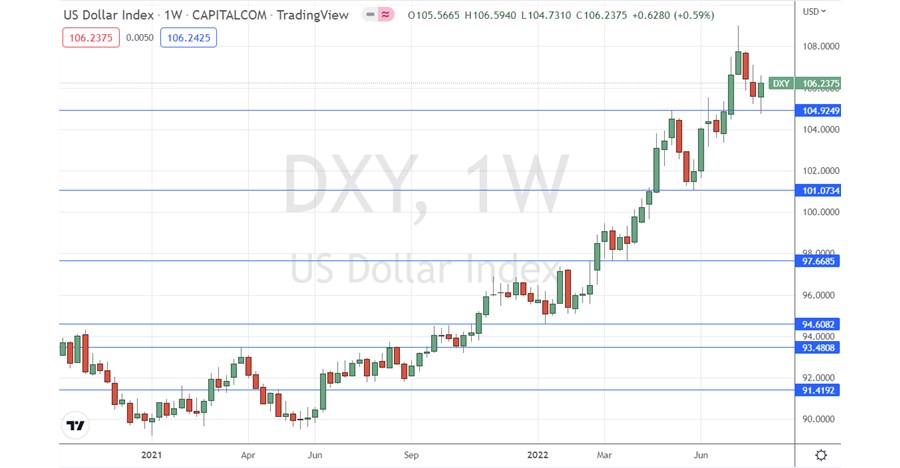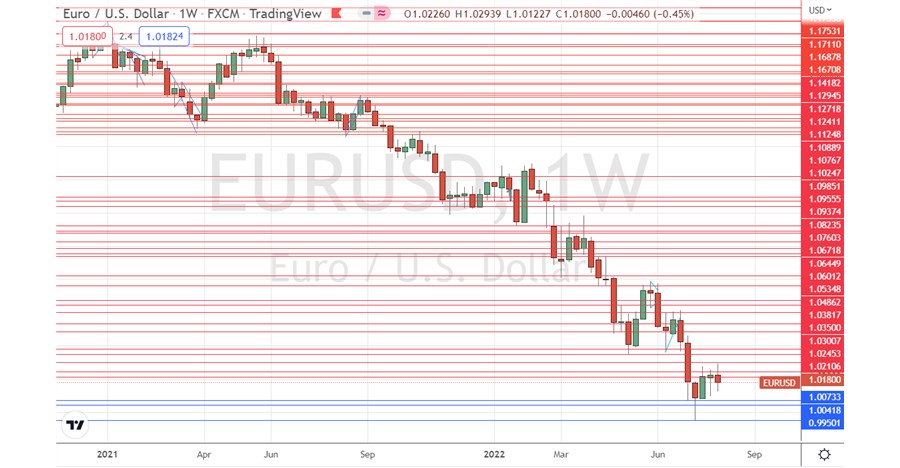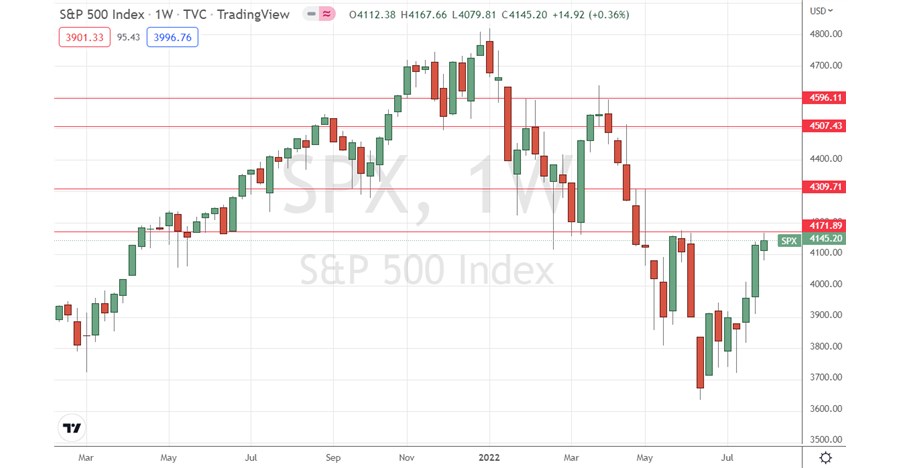The difference between success and failure in Forex / CFD trading is very likely to depend mostly upon which assets you choose to trade each week and in which direction, and not on the exact methods you might use to determine trade entries and exits.
So, when starting the week, it is a good idea to look at the big picture of what is developing in the market as a whole, and how such developments and affected by macro fundamentals, technical factors, and market sentiment. Read on to get my weekly analysis below.
Fundamental Analysis & Market Sentiment
I wrote in my previous piece on 17th July that the best trades for the week were likely to be:
- Short of EUR/USD following a daily (New York) close below parity ($1.0000).
- Long of USD/JPY following a daily (New York) close above €138.92 (ideally €139.00).
My forecast produced no trades as neither of these set-ups emerged over the week, which was enough to stay out of trouble on the long side.
The news is currently dominated by the higher-than-expected increase in average hourly earnings and net new non-farm payrolls jobs data which were announced last week. These data suggest that the US economy is still powering ahead and generating inflationary pressure, so the market took it as a sign that the Fed will have to maintain a very hawkish course of rate hikes and a generally tighter course of monetary policy. This boosted the US Dollar and the 2-year USD yield. US average hourly earnings rose by 0.5% over the month while an increase of only 0.3% had been forecast. Non-farm payroll jobs increased by 528,000 which was more than double the number expected.
US inflation data to be released this week is expected to show a month-on-month increase of 0.2%, with core CPI expected to climb by 0.5%.
The Bank of England raised its base rate by 0.50% last Thursday as had been expected, to a new rate of 1.75%. However, the Bank degraded its economic forecasts and is now expecting inflation to reach as high as 13% later this year, plus a five-quarter recession producing an economic contraction of 2.2% in GDP. This is one of the most negative outlooks seen in any G20 country.
The outlook regarding risk appetite is unclear. The US stock market is still in a bear market, but rose again last week, although the US yield curve remains inverted. The US has seen two successive quarters of GDP contraction but is not officially in a recession. If the US is in a recession, the slow down is very patchy so far.
To recap there were a few important economic data releases last week. The results were as follows:
US Average Hourly Earnings – an annualized rate of 0.5% was recorded compared to an expected 0.3%. This suggests inflationary pressures remain strong.
US Non-Farm Payrolls: 528k new jobs were created compared to an expected 250k. This suggests inflationary pressures remain strong.
The Bank of England raised its interest rate by 0.50% to a new rate of 1.75%.
The Reserve Bank of Australia raised its interest rate by 0.50% to a new rate of 1.85%.
US Jolts Job Openings came in almost as expected.
Swiss CPI data showed inflation unchanged month-on-month. A decline of 0.1% had been expected.
Canadian employment data came in slightly worse than expected.
The Forex market saw a firm advance by the US Dollar last week. The advance was broad but especially strong against the Japanese Yen, the British Pound, and the Australian and New Zealand Dollars.
Rates of coronavirus infection globally dropped last week for the third consecutive week. The most significant growths in new confirmed coronavirus cases overall right now are happening in Barbados, Chile, Japan, South Korea, Romania, and Serbia.
The Week Ahead: 8th August – 12th August 2022
The coming week in the markets is likely to show a higher level of volatility than last week, as the US CPI data release due has become the major event in the month’s Forex calendar. Releases due are, in order of likely importance:
British GDP data
US PPI data
US Preliminary UoM Consumer Sentiment data
It is a public holiday in Japan on Thursday 11th August.
Technical Analysis
U.S. Dollar Index
The weekly price chart below shows the U.S. Dollar Index printed a bullish candlestick which closed higher, in line with the long-term trend, which is bullish. This may be significant as the price seems to have rejected the support level shown by the blue horizontal line in the price chart below just below the 105.00 handle, with a long lower wick.
It will probably be a good idea to try to trade the US Dollar long over the coming week once it starts rising again on shorter time frames. This is a very powerful, long-term trend in the most important currency in the Forex market.

EUR/USD
Last week saw this currency pair print a bearish engulfing candlestick, but it looks a little weak as the real body is so narrow. However, the price has remained quite close to its recent 20-year lows below the parity level, which suggests that the bearish trend here is strong and worth persisting with.
The Euro has been showing some relatively strength, but I am quite confident it will move lower soon as we see such strong selling every time the price gets close to the $1.0300 handle.
Looking for short trades here when the hourly and 4-hour charts begin to make decisive lower highs will probably be the best strategy here over the coming week.

S&P 500 Index
The S&P 500 Index is technically in a bear market, but rose last week for the third consecutive week, although not by a large amount. However, it is notable that the price is not far from making a new 2-month high.
There has been short-term bullish price action that has enabled day traders to profit from longs on momentum days, but traders should zoom out and note the flipped support to resistance level which has now been printed at 4172, as shown within the below price chart.
A daily close this week above 4172 will be significant for bulls and suggest more upside. Alternatively, a failure following a test of that level followed by renewed bearish momentum could be a good short trade entry signal.

Bottom Line
I see the best opportunities in the financial markets this week as likely to be in looking for short-term short trades in the EUR/USD currency pair, and in trying to exploit the pivotal point in the S&P 500 Index at 4172 if it is reached.
Ready to trade our Forex weekly analysis? We’ve shortlisted the best Forex trading brokers in the industry for you.
